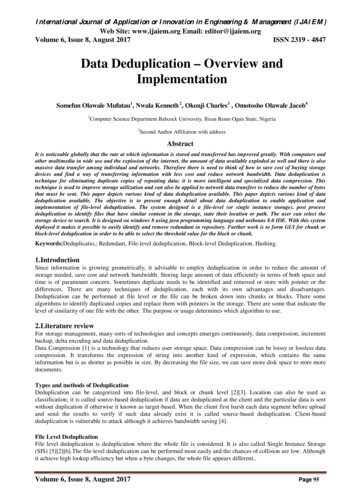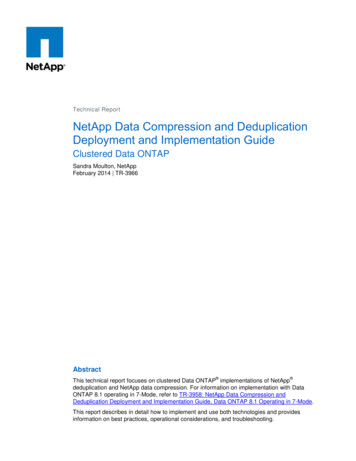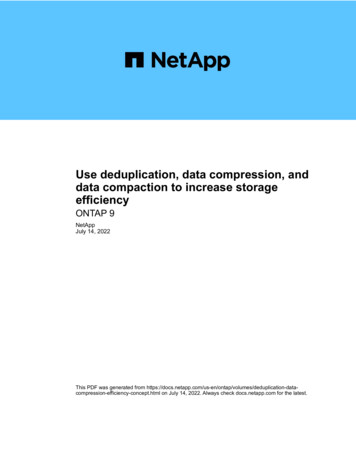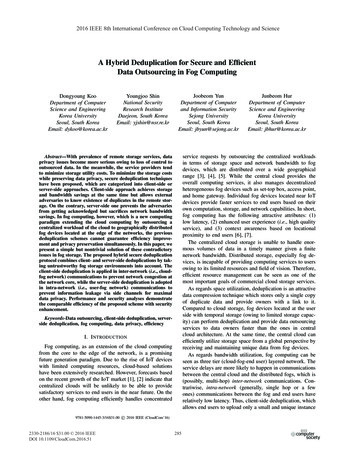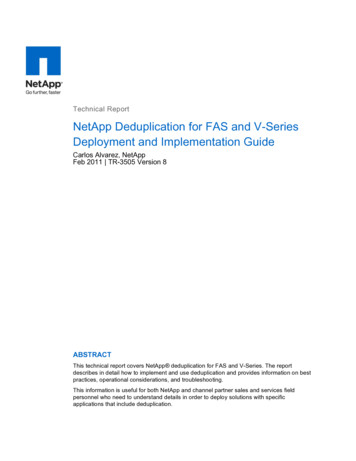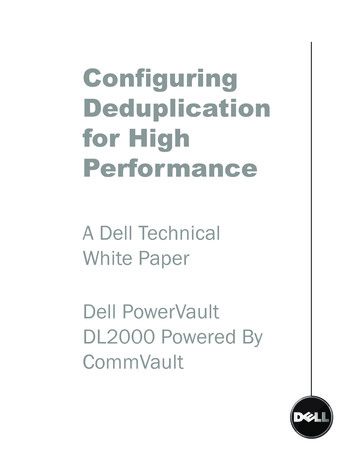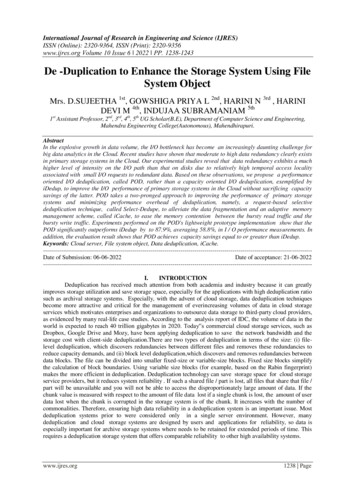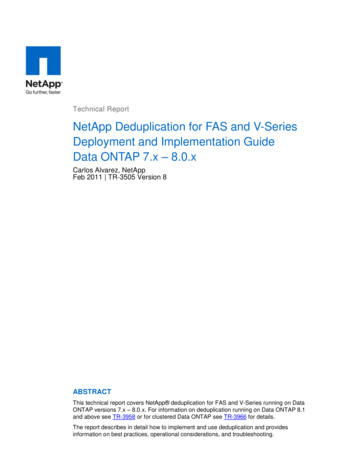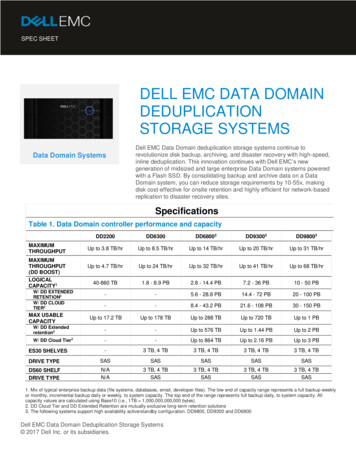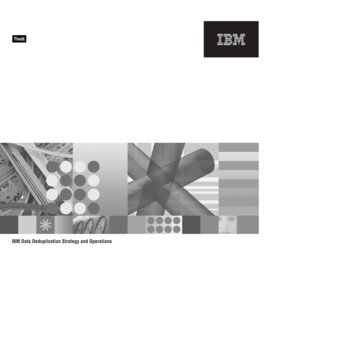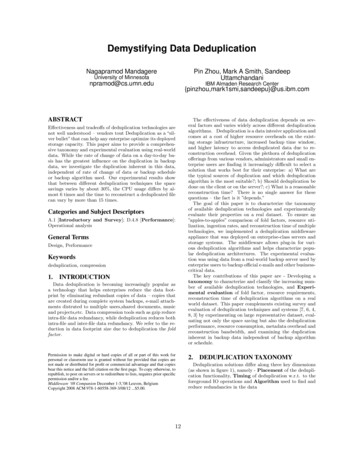
Transcription
Demystifying Data DeduplicationNagapramod MandagerePin Zhou, Mark A Smith, SandeepUttamchandaniUniversity of Minnesotanpramod@cs.umn.eduIBM Almaden Research CTEffectiveness and tradeoffs of deduplication technologies arenot well understood – vendors tout Deduplication as a “silver bullet” that can help any enterprise optimize its deployedstorage capacity. This paper aims to provide a comprehensive taxonomy and experimental evaluation using real-worlddata. While the rate of change of data on a day-to-day basis has the greatest influence on the duplication in backupdata, we investigate the duplication inherent in this data,independent of rate of change of data or backup scheduleor backup algorithm used. Our experimental results showthat between different deduplication techniques the spacesavings varies by about 30%, the CPU usage differs by almost 6 times and the time to reconstruct a deduplicated filecan vary by more than 15 times.Categories and Subject DescriptorsA.1 [Introductory and Survey]; D.4.8 [Performance]:Operational analysisGeneral TermsDesign, PerformanceKeywordsdeduplication, compression1.INTRODUCTIONData deduplication is becoming increasingly popular asa technology that helps enterprises reduce the data footprint by eliminating redundant copies of data – copies thatare created during complete system backups, e-mail attachments distruted to multiple users,shared documents, musicand projects,etc. Data compression tools such as gzip reduceintra-file data redundancy, while deduplication reduces bothintra-file and inter-file data redundancy. We refer to the reduction in data footprint size due to deduplication the foldfactor.Permission to make digital or hard copies of all or part of this work forpersonal or classroom use is granted without fee provided that copies arenot made or distributed for profit or commercial advantage and that copiesbear this notice and the full citation on the first page. To copy otherwise, torepublish, to post on servers or to redistribute to lists, requires prior specificpermission and/or a fee.Middleware ’08 Companion December 1-5,’08 Leuven, BelgiumCopyright 2008 ACM 978-1-60558-369-3/08/12 . 5.00.12The effectiveness of data deduplication depends on several factors and varies widely across different deduplicationalgorithms. Deduplication is a data intesive application andcomes at a cost of higher resource overheads on the existing storage infrastructure, increased backup time window,and higher latency to access deduplicated data due to reconstruction overhead. Given the plethora of deduplicationofferings from various vendors, administrators and small enterprise users are finding it increasingly difficult to select asolution that works best for their enterprise: a) What arethe typical sources of duplication and which deduplicationalgorithm is the most suitable?; b) Should deduplication bedone on the client or on the server?; c) What is a reasonablereconstruction time? There is no single answer for thesequestions – the fact is it ”depends.”The goal of this paper is to characterize the taxonomyof available deduplication technologies and experimentallyevaluate their properties on a real dataset. To ensure an”apples-to-apples” comparison of fold factors, resource utilization, ingestion rates, and reconstruction time of multipletechnologies, we implemented a deduplication middlewareappliance that was deployed on enterprise-class servers andstorage systems. The middleware allows plug-in for various deduplication algorithms and helps characterize popular deduplication architectures. The experimental evaluation was using data from a real-world backup server used byenterprise users to backup official e-mails and other businesscritical data.The key contributions of this paper are - Developing ataxonomy to characterize and classify the increasing number of available deduplication technologies, and Experimental evaluation of fold factor, resource requirements,reconstruction time of deduplication algorithms on a realworld dataset. This paper complements existing survey andevaluation of deduplication techniques and systems [7, 6, 4,8, 3] by experimenting on large representative dataset, evaluating not only the space saving but also the deduplicationperformance, resource consumption, metadata overhead andreconstruction bandwidth, and examining the duplicationinherent in backup data independent of backup algorithmor schedule.2.DEDUPLICATION TAXONOMYDeduplication solutions differ along three key dimensions(as shown in figure 1), namely - Placement of the deduplication functionality, Timing of deduplication w.r.t. to theforeground IO operations and Algorithm used to find andreduce redundancies in the data
Algor ithmVariable Block Hashing(VBH)Fixed Block Hashing(FBH)Whole File Hashing(WFH)Delta Encoding(DE)Servers/Backup ClientsDeduplication Appliancesthough primarily meant for backup/offline operation typically have powerful controllers too. However, placing deduplication functionality within a storage array rules out theoption of using any type of content-aware deduplication algorithms that operate by understanding the details of thedata; this is because existing Storage Arrays do not have thecapability to understand file system metadata, thereby limiting the choice of deduplication algorithms to block-based.In summary, the choice of placement in additionto affecting the resource utilization can potentiallylimit the timing/deduplication algorithm selection.I mplicationsResour ce ConsumptionCPU UtilizationNetwork UtilizationIO Bandwidth UtilizationPer for manceFold Factor Space SavedReconstruction Time (RTO)Deduplication Time(Backup -of-bandStorage Arrays/VTLsPlacement2.2Figure 1: Deduplication Design Space2.1 PlacementData deduplication can be done on the client, storage array/VTL or on an appliance.Client BasedDeduplication in the client follows a client-server approachwherein a deduplication client communicates with its servercounterpart installed on either a deduplication appliance orthe Storage Array itself. This type of deduplication is often referred to as transmission deduplication where in, thededuplication client processes the data, extracts deduplication metadata and exchanges it with its server counterpart.The server counterpart would use this metadata along withits own bookkeeping data to determine if duplication existsand communicates back the corresponding information tothe client. The deduplication client would transmit only theunique data over fibre channel or the IP network.Deduplication at the Client provides huge savings in network bandwidth. However, these savings come at a cost.Firstly, client side CPU and IO resources are used for detection of duplicates. Secondly, it has a wide range of security implications, since any client can query the StorageArray with deduplication metadata, one could attempt to reverse engineer the system to determine the contents storedby other backup clients on the same storage array. Lastly,client-side deduplication may affect the choice of deduplication timing at the server.Deduplication ApplianceA deduplication appliance is a special-purpose system thatimplements and performs deduplication. Typical deduplication appliances operate either in-band or out-of-band, connected to both the clients and the Storage Arrays. In-banddeduplication appliances examine all of the incoming dataas it arrives to find duplication before writing data to thestorage array, whereas out-of-band appliances perform thededuplication functionality after the data has been writtento disk. One main concern with in-band appliances is thatthe appliance could become a bottleneck in the IO path dueto the extra processing required by the system before writing the data to disk.Storage Arrays/VTLDisk Array controllers and Virtual Tape Library controllersprovide a very good platform for performing deduplication.Modern disk array controllers often have large computational resources and their proximity to data makes thema very interesting place to perform deduplication. VTLs13TimingDeduplication can be performed as Synchronous/In-Bandor as Asynchronous/Out-of-Band operation.Synchronous/In-Band Deduplication involves performing the deduplication operation as part of regular data requests. Every write request to the storage system involvesan attempt to perform deduplication (finding the match, ifany, and then updating metadata to reflect the deduplication operation) before actually writing data to disk. In-banddeduplication is amenable to client-side placement becausethe data store metadata synchronously reflects its contentsand can be queried immediately by clients, eliminating duplicate network traffic. Additionally, it facilitates thin provisioning of storage since no staging of data is required. Inband deduplication can add a significant amount of latencyto the system, e.g., in a backup environment, performingin-band deduplication would mean increasing the size of thebackup window.Asynchronous/Out-of-Band Deduplication involves performing deduplication at regular intervals or when the system reaches a high-water mark.It can be desirable in systemswhere the ingestion speed of data is the primary consideration. Main drawback is that it results in a large number of additional IO operations solely for the purpose ofdeduplication – data must be re-read from disk, and duplicate bytes must be reclaimed, often resulting in additionalwrite IOs. Though out-of-band deduplication could be intelligently scheduled to minimize interference with regular IOoperations, it can have a significant impact on power management schemes and load balancing windows. Out-of-banddeduplication limits the option of placement – deduplicationat the client is less beneficial due to lack of up-to-date deduplication metadata during run-time. Hence, many of thebenefits (like reduction in network bandwidth utilized fordeduplication) that one could achieve by placing deduplication functionality at the client is lost. Finally, out-of-banddeduplication necessitates provisioning for a larger footprintsince deduplication is performed at a later point in time,space to save the complete dataset is still required for staging purposes until deduplication can be performed.In summary, choice of timing may be restricted byplacement, but the main driver is the performancerequirements or Service Level Objectives (SLOs) ofthe storage subsystem.2.3Deduplication AlgorithmBased on the granularity of deduplication, algorithms arecategorized into three main categories: Whole File Hashing,Sub File Hashing and Delta Encoding.
Whole File Hashing (WFH): A SHA1 and/or MD5 hashfunction is applied to the content of each file to obtain theirhash signatures. Files with matching signatures are collectedand optionally a byte-to-byte comparison of them is performed as a safeguard from hash collisions.Sub File/Chunk Hashing: schemes use blocks/chunksas the granularity. Based on the strategy used for this division of files into blocks, two different approaches have beendeveloped, namely Fixed Block Hashing (FBH): Every file is divided intofixed-sized blocks starting from the beginning of the file. Ahash function like SHA1 or MD5 is used to compute thesignature of each chunk. A hash table is used to find exactmatch chunks and then optionally a byte-to-byte compareis used as safeguard against hash collisions.Variable Block Hashing (VBH): uses Rabin Fingerpriting [5] [1], a sliding window rolling hash based technique tosubdivide byte-streams into chunks with a high probabilityof matching other chunks generated likewise. If a signatureof the chuck/block matches one of the pre-computed or prespecified delimiters, the algorithm designates the end of thiswindow as a chunk boundary. Once the boundary has beenidentified, all bytes starting from the previous known chunkboundary to the end of the current window is designated achunk. A hash of this new chunk is computed and comparedagainst the signatures of all pre-existing chunks in the system. This approach has been proved to be very successful inidentifying similar chunks irrespective of their offsets withintheir corresponding files [6]. In practice, this method makesuse of four tuning parameters, namely - the minimum chunksize, the maximum chunk size, the average chunk size andthe window size.Delta Encoding/Compression (DE): Delta encoding [2]is a mechanism used to generate a delta (usually called patchfile) between two files. Given a reference file and a new file,delta encoding produces a delta or diff between the two.Just like inter-file compression techniques, this method simply uses copy/insert commands and outputs a patch file. Astream matching algorithm is used to locate matching offsets in the source and target versions, emitting a sequenceof copy instructions for each matching range and insert instructions to cover the unmatched regions. For an incomingfile to a system using DE, the most important implementation detail is how to select the file against which to producethe delta. Fingerprint matching can be used for detectionof resemblance between a given file and a set of files alreadyin the system.Algorithmic choices have several implications. Fold Factor to a large extent depends on the dataset itself. In someinstances, the difference/improvement between algorithmsmight be minimal. However, in general, VBH-based products are known to provide the best fold factor. The selectionof parameters for VBH has been found to be a tricky issue.One must balance the metadata overhead with the duplication detection in order to achieve best fold factors.Reconstruction time is an important metric and mostlydependent on the deduplication algorithm and the degree oflocality of the constituent chunks comprising the filesystem.Most of the algorithms that work at the granularity of fixedor variable-sized logical blocks have a high impact on recon-14struction time. This impact on reconstruction time is moreevident in systems that work on top of file systems. Typically these algorithms store each of these individual blocksas separate files. Hence, retrieval of a single deduplicatedfile could potentially result in retrieval of all its constituentblocks or files leading to long reconstruction times. If blocksizes chosen are very small compared to size of the originalfile, a single file reconstruction could lead to reading a largenumber of constituent files.In the case of in-band deduplication, the rate of deduplication is very important as it directly impacts the dataingestion rate. Deduplication times are very closely relatedto choice of deduplication algorithm. If using VBH, thedata must be both fingerprinted and hashed. With all algorithms, a lookup in a large table of data identifiers mustoccur. FBH and WFH algorithms both only require hashingof the data to uniquely identify it, and would have the leastimpact on data ingestion rates due to deduplication time.Out-of-band deduplication times are generally longer thanin-band because of the additional IO required to performthe deduplication. Whereas in-band systems operate on thedata while still in memory and before it is written to disk,out-of-band systems must re-read and reorganize the datato reclaim space during the deduplication process.Resource Consumption, which is dependent on thecomputational complexity of these algorithms, varies widely.In general, algorithms that work at a larger granularity consume less resources at the expense of fold factor.Inmost cases client CPU resources are either limited or expensive, hence algorithm choices might be restricted. Insome cases, network bandwidth might be considered moreexpensive (typically if geographically distributed). In summary, resource consumption could play a very critical rolein selection of the deduplication technology.In summary, the choice of Deduplication Algorithmis driven by folding factor, expected reconstructiontime, desired impact on ingestion rate, network speed,and availibility of CPU cycles. Table 1 summarizes thepopular deduplication products based on the above taxonomy.3.3.1EVALUATION METHODOLOGYSystem ConfigurationIn our test bed, the Deduplication Appliance performsout-of-band deduplication. It is a 2-way 2.4GHz Intel Pentium Xeon server with 4GBs of DDR2 RAM with a SANattached volume hosted by an IBM DX4000 series Disk Array with 20 10K RPM SCSI disks configured as a RAID 0volume. Prior to the experimental runs, by trial and errorwe found that using 32 threads achieves the best utilizationof compute and storage resources for our setup. Hence, weconfigure the system to use 32 instances of the DeduplicationProcess for the this comparison study.Experimental results that follow are for deduplication ofsame dataset/workload with variation of different deduplication algorithms and their tuning parameters.3.2DatasetThe dataset used in our evaluations consists of base Windows backups of 16 users totaling upto 450 GBs and 2,074,810files. No incremental backups are included in this analysisbecause we want to study the duplication inherent in the
ProductsData DomainDiligentAvamar(EMC)FalconStorNetwork AppliancesSepatonQuantumExaGrid SystemsSymantec ckup ClientsStorageArray/VTLVTLVTLVTLStorage rithmVBHVBHVBHSub File e 1: Classification of Deduplication .0% ofDataset20.18.45.95.04.93.33.12.72.51.7Avg. 19351623231267121961845Table 2: Statistics of the Top Ten File Typesbackup data, not due to multiple backups of the same or similar data. Very high aggregate fold factors can be achievedby performing daily full backups, but we focus on the duplication in the dataset itself to eliminate the influence ofbackup policies and schedules on the results.This dataset represents the backup and archival data ofemployees in the enterprise environment. Figure 2 showsthe cumulative distribution of the file sizes for this dataset.Table 2 provides the information on the file types whosetotal sizes are among the top ten in the dataset.File Size Distribution% of files below File 4M16M32M64M128M256M512M1G2G4G0File SizeFigure 2: Cummulative Distribution of File Sizes4.PERFORMANCE EVALUATIONChoice of Deduplication Algorithm typically dictates FoldFactor, Reconstruction Bandwidth, Metadata Overhead, andResource Usage. Typical deduplication systems apply thesame deduplication algorithm across all data types. In thissection we apply different deduplicaiton alogorithms, i.e.,VBH,FBH,WFH to the entire dataset to better understandthe differences between them. Table 3 and Figure 3 showthe comparison results for different algorithms and parameters.The minimum block size(min block size) is set to 12 avg block size and maximum block size (max block size)is set to to 2 avg block size. We use fixed window size(64 Bytes) for different VBH algorithms as our prior experiments showed that the window size has a negligible effecton the deduplication behavior.4.1 Fold Factor Comparison15AlgorithmFold 29215.90924.415.71120.57715.36317.92517.748Table 3: Deduplication ComparisonClearly for fold factor, VBH algorithms outperform bothFBH and WFH over all block sizes considered. Within VBH,smaller block sizes yield better fold factors. Both of theabove observations are consistent with the earlier discussionon the working of Variable Block Hashing schemes. Evenin case of FBH, smaller block sizes yield higher fold factors. In general, for sub-file chunking algorithms, the smallerthe block size, the higher the probability of finding identicalchunks.The difference in fold factor between comparable instances(similar block size parameters) of VBH and FBH decreasesas block size increases. At their optimal operating points VBH(16K) and FBH(16K) - space reduction achieved usingVBH is about 3.9% higher than that achieved using FBH.At the maximum tested block size of 512KB, this differencenarrows down to about 1.2%. Possible reasons for this behavior are - Firstly, by using larger blocks the probabilitythat a single different byte between blocks increases, andbecause this difference is contained in a larger block, theentire block including the identical portions of the block arestored independently and Secondly, the number of files thatare contained in single such blocks is high, as illustrated inFigure 2. A point worth noting is that even with simpleWFH-based schemes, an appreciable amount of space reduction is achievable. In our dataset use of WFH amountsto a space reduction of about 23%.As we can see, deduplication inherent in backup data isconsiderable (as high as 1.6 of fold factor with VBH(16K)),but should not be confused with the large fold factors associated with multi-day cumulative deduplication. Fold factorsof 1.5 to 2.0 seem reasonable to expect out of a single day’sbackup data. Achieving much larger fold factors in the rangeof 20 or 30 requires multi-day repeated backups and is heavilydependent upon the backup algorithm and schedule.4.2Reconstruction BandwidthColumn 3 in Table 3 shows the comparison of read orreconstruction bandwidth for different algorithms. Readspeeds on deduplicated datasets are a direct function of the
block size parameter of deduplication algorithms. Our prototype system currently does not implement any optimizations in read or reconstruction path between the applianceand the underlying data store. In such a system, using experiments with whole file hashing as an approximate baselineand seeing the relative differences of it yields generalizableresults. For WFH, the read bandwidth was about 19MBps.Compared to WFH, the sub-file chunking based schemes areable to provide far less read throughput. In addition, thisthroughput reduces with the block size parameter. This isbecause each extent is stored as a separate file due to thefact that typical deduplication schemes work on top of filesystems. Reconstructing any original file therefore involvesreading multiple files. For deduplication systems that workon top of standard file systems, controlling on disk layout ofthese constituent files is possible by implementing contiguous segment containers. However, this technique is limitedby the fragmentation inherent in deduplicated data. As aresult, reconstructing a single file involves multiple randomreads (as many as one per constituent extent) resulting indecreased read throughputs.Contrasting this reconstruction performance with the foldfactor analysis given before yields a valuable insight: tryingto achieve best space efficiency by choosing minimal blocksizes has an adverse impact on reconstruction time. Further, for many datatypes, fold factors do not improve muchby using smaller block sizes. In such cases, blindly usingsmaller block sizes will yield very little benefit in terms ofspace, while leading to further degradation in reconstructiontime.4.3 Metadata OverheadAs mentioned in the taxonomy section, the block sizesused for deduplication dictate the amount of extra metadata that one needs to maintain. Metadata here includesthe bookkeeping structure that stores hash signatures ofunique blocks and the object to extent(s) mapping information. The exact size of these types of information can varyacross different implementations. Column 2 in table 3 quantifies the metadata overhead in our implementation whichtries to optimize such overhead. Clearly, the difference inmetadata sizes between the sub-file chunking algorithms isminimal. However, the actual size of the metadata is significant. This is because because if the metadata cannotbe stored completely in memory, then the part of metadata stored on disk will cause disk reads for hash lookups.For instance, in our implementation the metadata size isabout 2.2GB for running FBH(16K) on our archive/backupdataset leading to virtual paging. This causes an abnormalylong deduplication time for FBH(16K) as shown in Table 3.Recent work has increased the in-memory hit-rate of thesededuplication hash tables to as much as 99% by leveraging Bloom Filters and locality-aware caching, reducing thisrequirement[8]. However, such approaches have only beenproven to work in certain backup domains and hence theinitial planning or provisioning of deduplication hardwarestill needs to account for metadata needs as the fragmentation of the system increases, and the locality-aware cachingbecomes less effective.Therefore, compared to the size of the dataset, deduplication metadata is small, but significant in terms of systemperformance impact.164.4Resource ImpactGiven that deduplication is typically a bulk data manipulation operation, an understanding of the necessary resources required to achieve or support this operation is veryimportant in making system-wide provisioning decisions. Ashighlighted in Section 2, resource usage is dependent not juston the algorithm used, but also the placement and timing ofdeduplication. Figure 3 shows a comparison of CPU usagecharacteristics for the three algorithms and their variations.Figures 3(a) and 3(b) show the utilization of the CPU bythe deduplication process and the time taken for deduplication process to complete respectively. As the block sizedecreases, the number of hash lookups and hash updatesincrease, consequently consuming more CPU cycles. In addition, the rate of decrease of computation time of SHA1hash operation does not decrease linearly with block size.Hence in general, one would expect higher CPU utilizationwith smaller block sizes for both VBH and FBH. However,our results show that CPU utilization for a 16KB block sizeis significantly lower than any block size greater than 16KB.On further investigation we found two main reasons for thisbehavior, - Firstly, we found that with a 16KB block size, theavailable memory during the deduplication process droppeddown to almost zero. As a result of this unavailability ofphysical memory, our bookkeeping data structures (2.7GB)used by the deduplication process could no longer be maintained in the physical memory in its entirety resulting inpaging to disk. Hence, hash table lookups slow down by anorder of magnitude. Secondly, with a 16KB blocksize, thefilesystem makes IO requests of a size far smaller than theLogical Block Size on the Disk Array resulting in inefficientaccess. In our system, the Logical Block Size was configured as 64KB. The CPU utilization for block size other than16KB is greatly dependent on the IO subsystem. Since theoffline deduplication process performs random IO on the disksubsystem, even with a large number of concurrent deduplication threads, we found that the CPU utilization wasaffected by the IO bottleneck.Both the CPU Utilization and Deduplication Times areimpacted by certain hidden system factors due to which general conclusions should not and cannot be drawn from them.For instance, CPU and IO bottlenecks vary widely acrosssystems. Hence, both these metrics need to be consideredtogether to understand and draw generalizations about theCPU characteristics of different algorithms. This leads usto a derived metric - CPU Cycles consumed - a product ofthe CPU utilization and the total duration for which theCPU was used. Figure 3(c) shows the variation of CPUCycles consumed with with different algorithms. This metric clearly shows the difference in CPU usage of these algorithms. VBH and its variations consume a large number ofCPU cycles while finding the most duplicates. For instance,at a block size of 16KB, VBH consumes about 230% moreCPU cycles than a comparable instance of FBH. VBH is 3.3times as CPU intensive as FBH given that IO subsystem isnot a bottleneck. An interesting point to note here is thatthough CPU cycles consumed by both WFH and FBH withblock size 512KB are almost equal, FBH delivers a fold factor of 1.486 as against 1.31 for WFH. In essence, with similarCPU consumption, FBH can potentially deliver better spacesavings.Compute resources consumed by deduplication processescould potentially make or break placement decisions. For in-
163264 128 256 512 WFComparison of Deduplication Time504030201001632Avg. Block Size (KBs)64 128 256 512 WFAvg. Block Size (KBs)VSH(a) CPU UtilizationComparison of CPU Cycles Consumed60CPU Cycles(G)Deduplication Time(hrs)% CPU UtilizationComparison of CPU 0004000020000016 32 64 128 256 512 WFAvg. Block Size (KBs)WFH(b) Deduplication Time(c) CPU CyclesFigure 3: Comparison of CPU Consumptionsstance, compute resources on servers in general are far moreexpensive than on dedicated appliances. Further, usage ofCPU is interleaved in manners in which it could potentiallyhave a drastic impact on performance of other applications.Hence, the tradeoff between deduplication performance andresource usage needs to be considered on a case by case basisbefore making deployment decisions. For instance, in deployments where a network bandwidth between servers andstorage is expensive, and CPU cycles on servers are cheap,the best choice might be VSH with smallest block size.5.DISCUSSION & LESSONS LEARNEDBased on extensive review of various deduplication technologies/vendor offerings and evaluation of a prototype deduplication system, i
The e ectiveness of data deduplication depends on sev-eral factors and varies widely across di erent deduplication algorithms. Deduplication is a data intesive application and comes at a cost of higher resource overheads on the exist-ing storage infrastructure, increased backup time window, and higher latency to access deduplicated data due to re-
